Strategic Management and Leadership: Decision Making and Impact Report
VerifiedAdded on 2019/09/26
|9
|3646
|164
Report
AI Summary
This report delves into the intricate relationship between leadership and management, emphasizing their crucial roles in strategic decision-making within organizations. It begins by defining management and leadership, highlighting their interconnectedness and the importance of leadership in effective management. The report then explores the Potter's Pipeline Model to understand the link between strategic management and leadership, followed by an analysis of how management and leadership skills influence strategic decisions, including the impact of leadership styles. The report examines the adaptation of leadership styles, the impact of situational and transformational leadership theories, and the development of leadership strategies to support organizational direction. Furthermore, the report reviews current leadership requirements using the trait theory of leadership, focusing on the qualities and skills necessary for effective leadership and the transformation of organizational culture. The analysis underscores the importance of leadership in fostering a competitive advantage and achieving organizational goals through effective decision-making, innovation, and employee motivation.
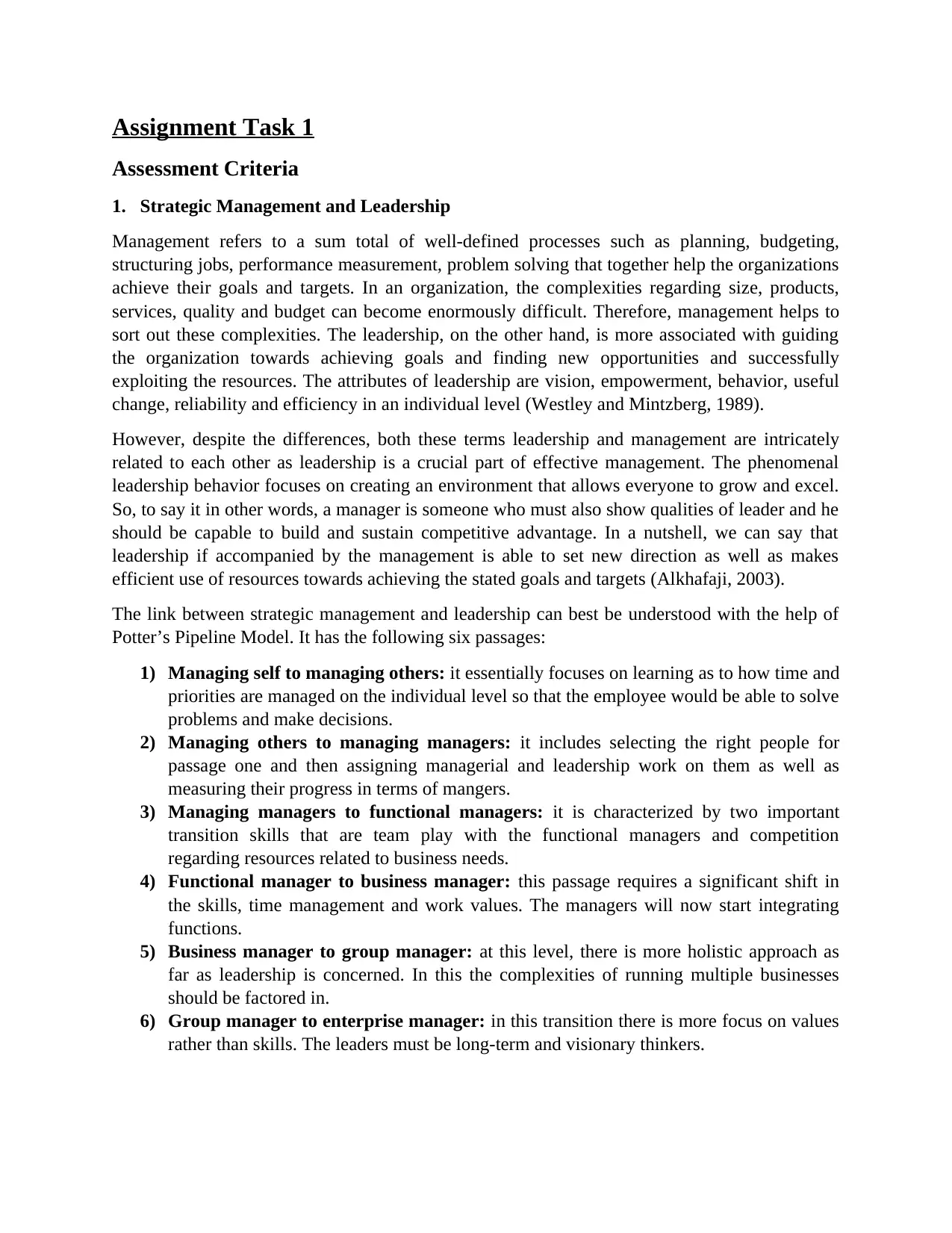
Assignment Task 1
Assessment Criteria
1. Strategic Management and Leadership
Management refers to a sum total of well-defined processes such as planning, budgeting,
structuring jobs, performance measurement, problem solving that together help the organizations
achieve their goals and targets. In an organization, the complexities regarding size, products,
services, quality and budget can become enormously difficult. Therefore, management helps to
sort out these complexities. The leadership, on the other hand, is more associated with guiding
the organization towards achieving goals and finding new opportunities and successfully
exploiting the resources. The attributes of leadership are vision, empowerment, behavior, useful
change, reliability and efficiency in an individual level (Westley and Mintzberg, 1989).
However, despite the differences, both these terms leadership and management are intricately
related to each other as leadership is a crucial part of effective management. The phenomenal
leadership behavior focuses on creating an environment that allows everyone to grow and excel.
So, to say it in other words, a manager is someone who must also show qualities of leader and he
should be capable to build and sustain competitive advantage. In a nutshell, we can say that
leadership if accompanied by the management is able to set new direction as well as makes
efficient use of resources towards achieving the stated goals and targets (Alkhafaji, 2003).
The link between strategic management and leadership can best be understood with the help of
Potter’s Pipeline Model. It has the following six passages:
1) Managing self to managing others: it essentially focuses on learning as to how time and
priorities are managed on the individual level so that the employee would be able to solve
problems and make decisions.
2) Managing others to managing managers: it includes selecting the right people for
passage one and then assigning managerial and leadership work on them as well as
measuring their progress in terms of mangers.
3) Managing managers to functional managers: it is characterized by two important
transition skills that are team play with the functional managers and competition
regarding resources related to business needs.
4) Functional manager to business manager: this passage requires a significant shift in
the skills, time management and work values. The managers will now start integrating
functions.
5) Business manager to group manager: at this level, there is more holistic approach as
far as leadership is concerned. In this the complexities of running multiple businesses
should be factored in.
6) Group manager to enterprise manager: in this transition there is more focus on values
rather than skills. The leaders must be long-term and visionary thinkers.
Assessment Criteria
1. Strategic Management and Leadership
Management refers to a sum total of well-defined processes such as planning, budgeting,
structuring jobs, performance measurement, problem solving that together help the organizations
achieve their goals and targets. In an organization, the complexities regarding size, products,
services, quality and budget can become enormously difficult. Therefore, management helps to
sort out these complexities. The leadership, on the other hand, is more associated with guiding
the organization towards achieving goals and finding new opportunities and successfully
exploiting the resources. The attributes of leadership are vision, empowerment, behavior, useful
change, reliability and efficiency in an individual level (Westley and Mintzberg, 1989).
However, despite the differences, both these terms leadership and management are intricately
related to each other as leadership is a crucial part of effective management. The phenomenal
leadership behavior focuses on creating an environment that allows everyone to grow and excel.
So, to say it in other words, a manager is someone who must also show qualities of leader and he
should be capable to build and sustain competitive advantage. In a nutshell, we can say that
leadership if accompanied by the management is able to set new direction as well as makes
efficient use of resources towards achieving the stated goals and targets (Alkhafaji, 2003).
The link between strategic management and leadership can best be understood with the help of
Potter’s Pipeline Model. It has the following six passages:
1) Managing self to managing others: it essentially focuses on learning as to how time and
priorities are managed on the individual level so that the employee would be able to solve
problems and make decisions.
2) Managing others to managing managers: it includes selecting the right people for
passage one and then assigning managerial and leadership work on them as well as
measuring their progress in terms of mangers.
3) Managing managers to functional managers: it is characterized by two important
transition skills that are team play with the functional managers and competition
regarding resources related to business needs.
4) Functional manager to business manager: this passage requires a significant shift in
the skills, time management and work values. The managers will now start integrating
functions.
5) Business manager to group manager: at this level, there is more holistic approach as
far as leadership is concerned. In this the complexities of running multiple businesses
should be factored in.
6) Group manager to enterprise manager: in this transition there is more focus on values
rather than skills. The leaders must be long-term and visionary thinkers.
Paraphrase This Document
Need a fresh take? Get an instant paraphrase of this document with our AI Paraphraser
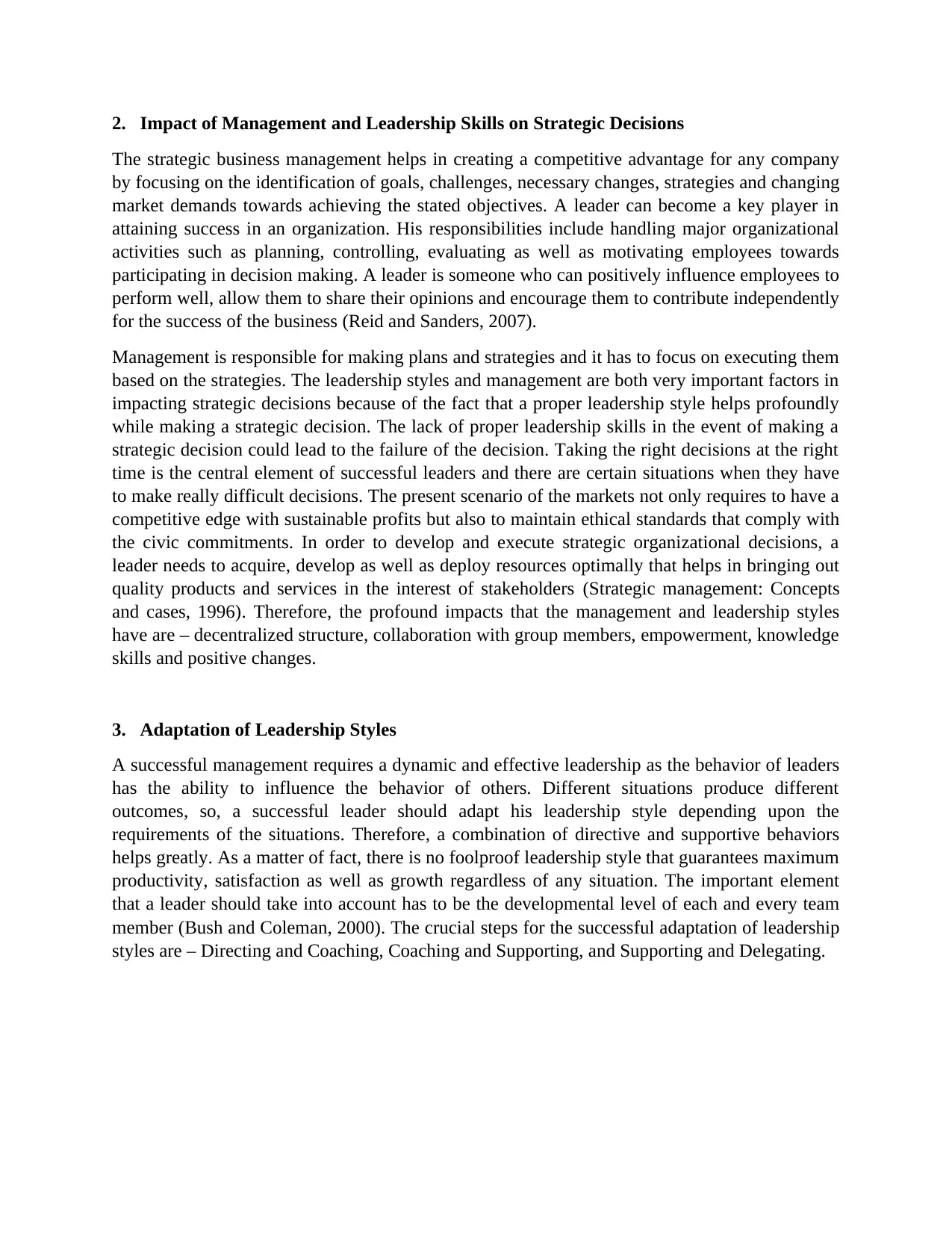
2. Impact of Management and Leadership Skills on Strategic Decisions
The strategic business management helps in creating a competitive advantage for any company
by focusing on the identification of goals, challenges, necessary changes, strategies and changing
market demands towards achieving the stated objectives. A leader can become a key player in
attaining success in an organization. His responsibilities include handling major organizational
activities such as planning, controlling, evaluating as well as motivating employees towards
participating in decision making. A leader is someone who can positively influence employees to
perform well, allow them to share their opinions and encourage them to contribute independently
for the success of the business (Reid and Sanders, 2007).
Management is responsible for making plans and strategies and it has to focus on executing them
based on the strategies. The leadership styles and management are both very important factors in
impacting strategic decisions because of the fact that a proper leadership style helps profoundly
while making a strategic decision. The lack of proper leadership skills in the event of making a
strategic decision could lead to the failure of the decision. Taking the right decisions at the right
time is the central element of successful leaders and there are certain situations when they have
to make really difficult decisions. The present scenario of the markets not only requires to have a
competitive edge with sustainable profits but also to maintain ethical standards that comply with
the civic commitments. In order to develop and execute strategic organizational decisions, a
leader needs to acquire, develop as well as deploy resources optimally that helps in bringing out
quality products and services in the interest of stakeholders (Strategic management: Concepts
and cases, 1996). Therefore, the profound impacts that the management and leadership styles
have are – decentralized structure, collaboration with group members, empowerment, knowledge
skills and positive changes.
3. Adaptation of Leadership Styles
A successful management requires a dynamic and effective leadership as the behavior of leaders
has the ability to influence the behavior of others. Different situations produce different
outcomes, so, a successful leader should adapt his leadership style depending upon the
requirements of the situations. Therefore, a combination of directive and supportive behaviors
helps greatly. As a matter of fact, there is no foolproof leadership style that guarantees maximum
productivity, satisfaction as well as growth regardless of any situation. The important element
that a leader should take into account has to be the developmental level of each and every team
member (Bush and Coleman, 2000). The crucial steps for the successful adaptation of leadership
styles are – Directing and Coaching, Coaching and Supporting, and Supporting and Delegating.
The strategic business management helps in creating a competitive advantage for any company
by focusing on the identification of goals, challenges, necessary changes, strategies and changing
market demands towards achieving the stated objectives. A leader can become a key player in
attaining success in an organization. His responsibilities include handling major organizational
activities such as planning, controlling, evaluating as well as motivating employees towards
participating in decision making. A leader is someone who can positively influence employees to
perform well, allow them to share their opinions and encourage them to contribute independently
for the success of the business (Reid and Sanders, 2007).
Management is responsible for making plans and strategies and it has to focus on executing them
based on the strategies. The leadership styles and management are both very important factors in
impacting strategic decisions because of the fact that a proper leadership style helps profoundly
while making a strategic decision. The lack of proper leadership skills in the event of making a
strategic decision could lead to the failure of the decision. Taking the right decisions at the right
time is the central element of successful leaders and there are certain situations when they have
to make really difficult decisions. The present scenario of the markets not only requires to have a
competitive edge with sustainable profits but also to maintain ethical standards that comply with
the civic commitments. In order to develop and execute strategic organizational decisions, a
leader needs to acquire, develop as well as deploy resources optimally that helps in bringing out
quality products and services in the interest of stakeholders (Strategic management: Concepts
and cases, 1996). Therefore, the profound impacts that the management and leadership styles
have are – decentralized structure, collaboration with group members, empowerment, knowledge
skills and positive changes.
3. Adaptation of Leadership Styles
A successful management requires a dynamic and effective leadership as the behavior of leaders
has the ability to influence the behavior of others. Different situations produce different
outcomes, so, a successful leader should adapt his leadership style depending upon the
requirements of the situations. Therefore, a combination of directive and supportive behaviors
helps greatly. As a matter of fact, there is no foolproof leadership style that guarantees maximum
productivity, satisfaction as well as growth regardless of any situation. The important element
that a leader should take into account has to be the developmental level of each and every team
member (Bush and Coleman, 2000). The crucial steps for the successful adaptation of leadership
styles are – Directing and Coaching, Coaching and Supporting, and Supporting and Delegating.
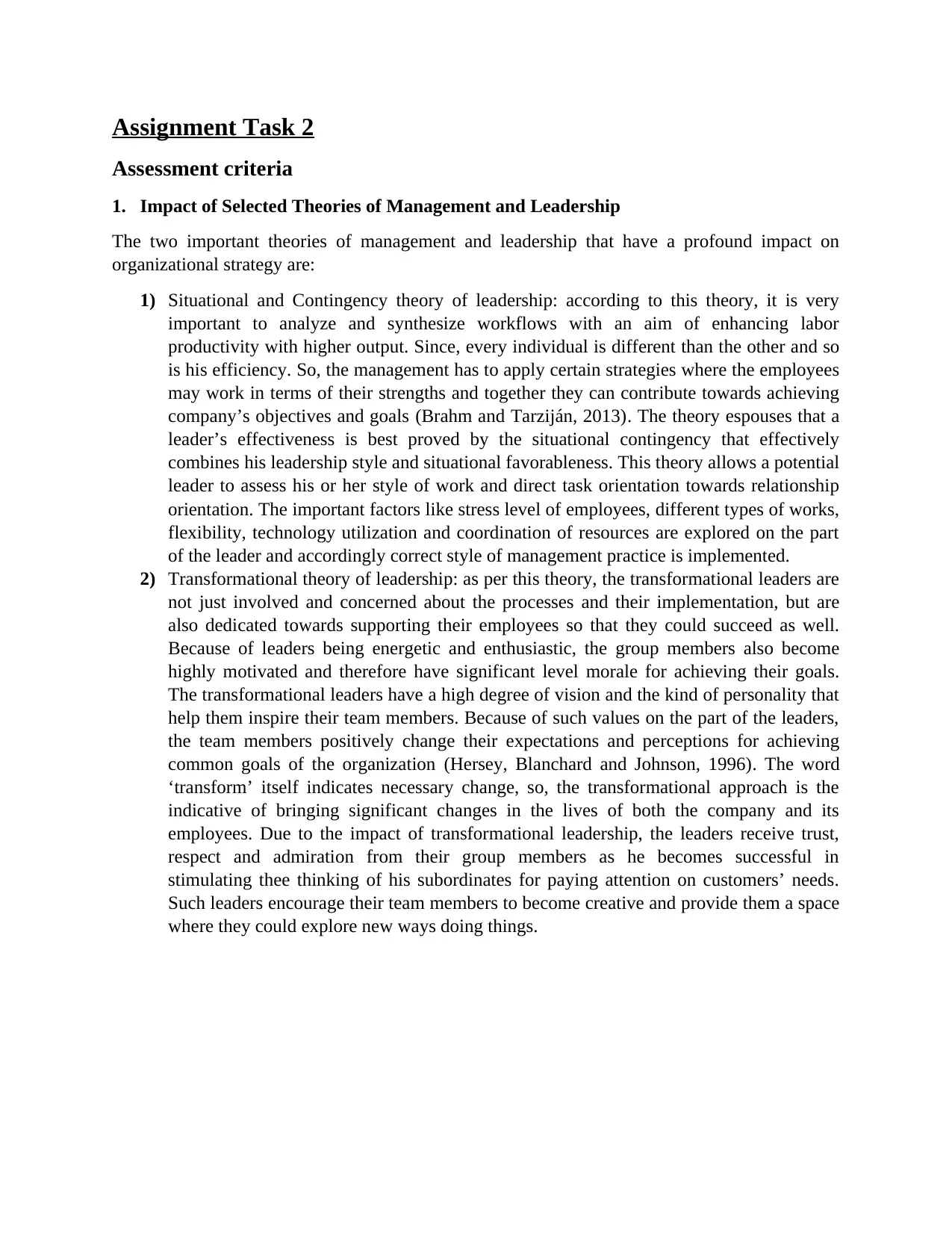
Assignment Task 2
Assessment criteria
1. Impact of Selected Theories of Management and Leadership
The two important theories of management and leadership that have a profound impact on
organizational strategy are:
1) Situational and Contingency theory of leadership: according to this theory, it is very
important to analyze and synthesize workflows with an aim of enhancing labor
productivity with higher output. Since, every individual is different than the other and so
is his efficiency. So, the management has to apply certain strategies where the employees
may work in terms of their strengths and together they can contribute towards achieving
company’s objectives and goals (Brahm and Tarziján, 2013). The theory espouses that a
leader’s effectiveness is best proved by the situational contingency that effectively
combines his leadership style and situational favorableness. This theory allows a potential
leader to assess his or her style of work and direct task orientation towards relationship
orientation. The important factors like stress level of employees, different types of works,
flexibility, technology utilization and coordination of resources are explored on the part
of the leader and accordingly correct style of management practice is implemented.
2) Transformational theory of leadership: as per this theory, the transformational leaders are
not just involved and concerned about the processes and their implementation, but are
also dedicated towards supporting their employees so that they could succeed as well.
Because of leaders being energetic and enthusiastic, the group members also become
highly motivated and therefore have significant level morale for achieving their goals.
The transformational leaders have a high degree of vision and the kind of personality that
help them inspire their team members. Because of such values on the part of the leaders,
the team members positively change their expectations and perceptions for achieving
common goals of the organization (Hersey, Blanchard and Johnson, 1996). The word
‘transform’ itself indicates necessary change, so, the transformational approach is the
indicative of bringing significant changes in the lives of both the company and its
employees. Due to the impact of transformational leadership, the leaders receive trust,
respect and admiration from their group members as he becomes successful in
stimulating thee thinking of his subordinates for paying attention on customers’ needs.
Such leaders encourage their team members to become creative and provide them a space
where they could explore new ways doing things.
Assessment criteria
1. Impact of Selected Theories of Management and Leadership
The two important theories of management and leadership that have a profound impact on
organizational strategy are:
1) Situational and Contingency theory of leadership: according to this theory, it is very
important to analyze and synthesize workflows with an aim of enhancing labor
productivity with higher output. Since, every individual is different than the other and so
is his efficiency. So, the management has to apply certain strategies where the employees
may work in terms of their strengths and together they can contribute towards achieving
company’s objectives and goals (Brahm and Tarziján, 2013). The theory espouses that a
leader’s effectiveness is best proved by the situational contingency that effectively
combines his leadership style and situational favorableness. This theory allows a potential
leader to assess his or her style of work and direct task orientation towards relationship
orientation. The important factors like stress level of employees, different types of works,
flexibility, technology utilization and coordination of resources are explored on the part
of the leader and accordingly correct style of management practice is implemented.
2) Transformational theory of leadership: as per this theory, the transformational leaders are
not just involved and concerned about the processes and their implementation, but are
also dedicated towards supporting their employees so that they could succeed as well.
Because of leaders being energetic and enthusiastic, the group members also become
highly motivated and therefore have significant level morale for achieving their goals.
The transformational leaders have a high degree of vision and the kind of personality that
help them inspire their team members. Because of such values on the part of the leaders,
the team members positively change their expectations and perceptions for achieving
common goals of the organization (Hersey, Blanchard and Johnson, 1996). The word
‘transform’ itself indicates necessary change, so, the transformational approach is the
indicative of bringing significant changes in the lives of both the company and its
employees. Due to the impact of transformational leadership, the leaders receive trust,
respect and admiration from their group members as he becomes successful in
stimulating thee thinking of his subordinates for paying attention on customers’ needs.
Such leaders encourage their team members to become creative and provide them a space
where they could explore new ways doing things.
⊘ This is a preview!⊘
Do you want full access?
Subscribe today to unlock all pages.

Trusted by 1+ million students worldwide
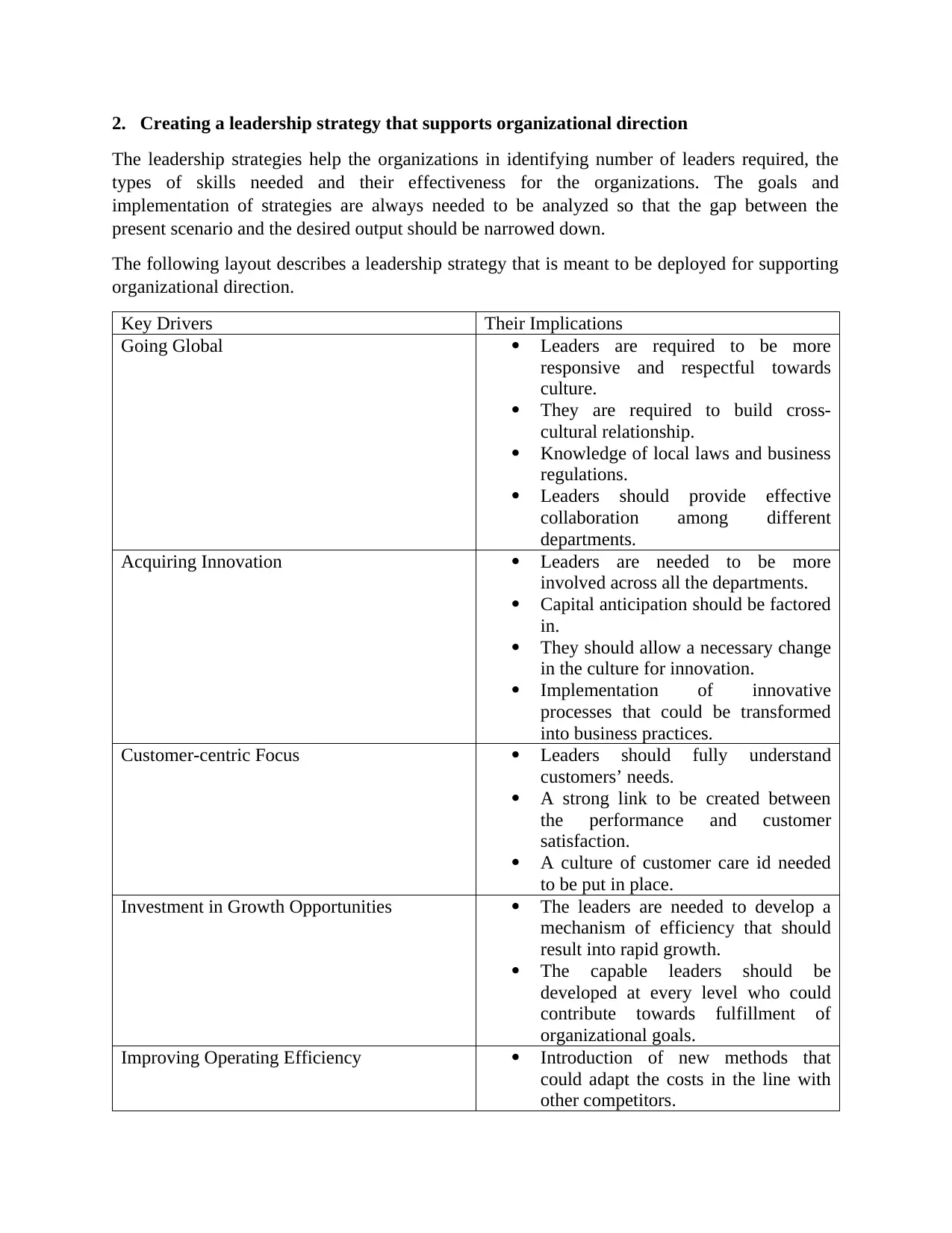
2. Creating a leadership strategy that supports organizational direction
The leadership strategies help the organizations in identifying number of leaders required, the
types of skills needed and their effectiveness for the organizations. The goals and
implementation of strategies are always needed to be analyzed so that the gap between the
present scenario and the desired output should be narrowed down.
The following layout describes a leadership strategy that is meant to be deployed for supporting
organizational direction.
Key Drivers Their Implications
Going Global Leaders are required to be more
responsive and respectful towards
culture.
They are required to build cross-
cultural relationship.
Knowledge of local laws and business
regulations.
Leaders should provide effective
collaboration among different
departments.
Acquiring Innovation Leaders are needed to be more
involved across all the departments.
Capital anticipation should be factored
in.
They should allow a necessary change
in the culture for innovation.
Implementation of innovative
processes that could be transformed
into business practices.
Customer-centric Focus Leaders should fully understand
customers’ needs.
A strong link to be created between
the performance and customer
satisfaction.
A culture of customer care id needed
to be put in place.
Investment in Growth Opportunities The leaders are needed to develop a
mechanism of efficiency that should
result into rapid growth.
The capable leaders should be
developed at every level who could
contribute towards fulfillment of
organizational goals.
Improving Operating Efficiency Introduction of new methods that
could adapt the costs in the line with
other competitors.
The leadership strategies help the organizations in identifying number of leaders required, the
types of skills needed and their effectiveness for the organizations. The goals and
implementation of strategies are always needed to be analyzed so that the gap between the
present scenario and the desired output should be narrowed down.
The following layout describes a leadership strategy that is meant to be deployed for supporting
organizational direction.
Key Drivers Their Implications
Going Global Leaders are required to be more
responsive and respectful towards
culture.
They are required to build cross-
cultural relationship.
Knowledge of local laws and business
regulations.
Leaders should provide effective
collaboration among different
departments.
Acquiring Innovation Leaders are needed to be more
involved across all the departments.
Capital anticipation should be factored
in.
They should allow a necessary change
in the culture for innovation.
Implementation of innovative
processes that could be transformed
into business practices.
Customer-centric Focus Leaders should fully understand
customers’ needs.
A strong link to be created between
the performance and customer
satisfaction.
A culture of customer care id needed
to be put in place.
Investment in Growth Opportunities The leaders are needed to develop a
mechanism of efficiency that should
result into rapid growth.
The capable leaders should be
developed at every level who could
contribute towards fulfillment of
organizational goals.
Improving Operating Efficiency Introduction of new methods that
could adapt the costs in the line with
other competitors.
Paraphrase This Document
Need a fresh take? Get an instant paraphrase of this document with our AI Paraphraser
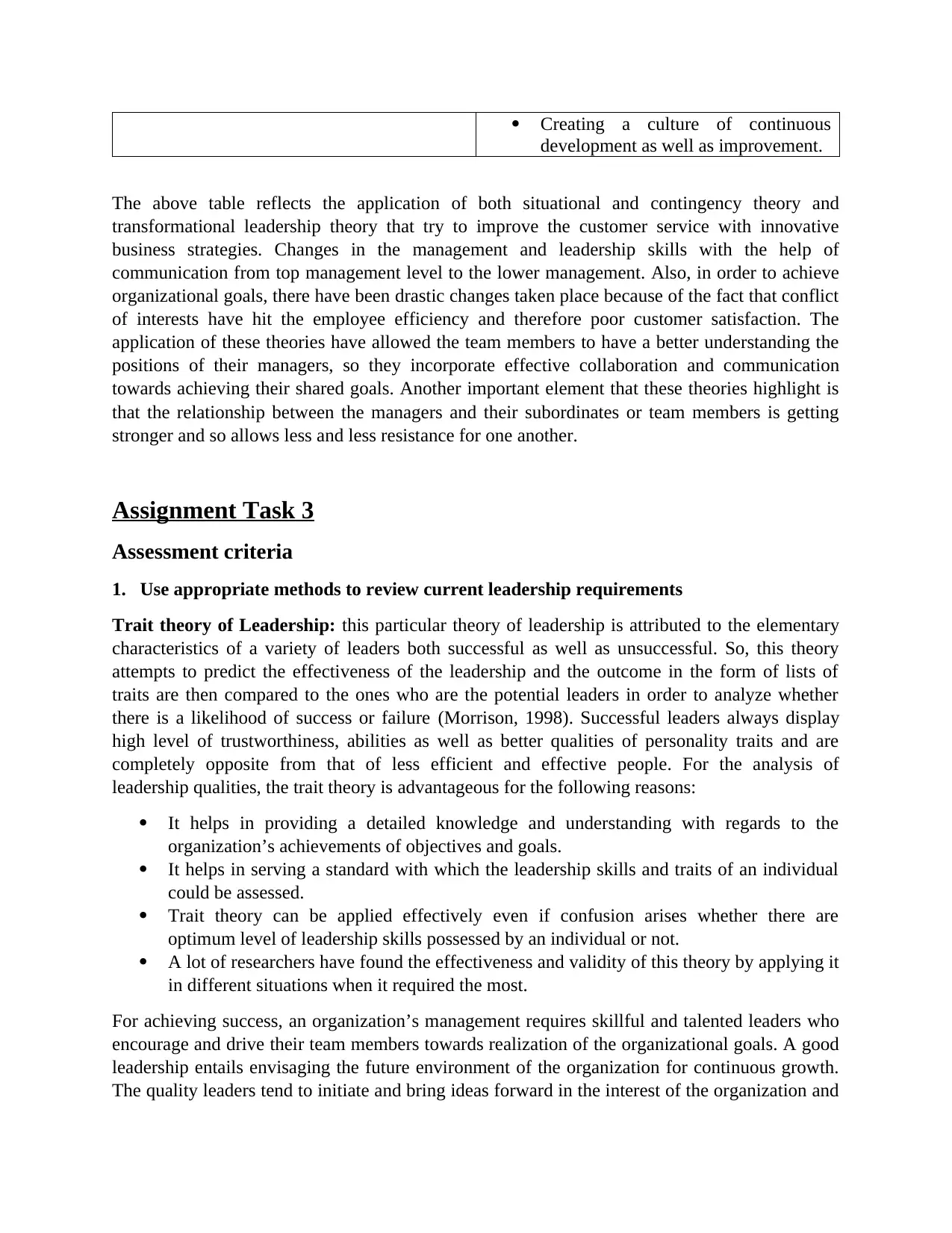
Creating a culture of continuous
development as well as improvement.
The above table reflects the application of both situational and contingency theory and
transformational leadership theory that try to improve the customer service with innovative
business strategies. Changes in the management and leadership skills with the help of
communication from top management level to the lower management. Also, in order to achieve
organizational goals, there have been drastic changes taken place because of the fact that conflict
of interests have hit the employee efficiency and therefore poor customer satisfaction. The
application of these theories have allowed the team members to have a better understanding the
positions of their managers, so they incorporate effective collaboration and communication
towards achieving their shared goals. Another important element that these theories highlight is
that the relationship between the managers and their subordinates or team members is getting
stronger and so allows less and less resistance for one another.
Assignment Task 3
Assessment criteria
1. Use appropriate methods to review current leadership requirements
Trait theory of Leadership: this particular theory of leadership is attributed to the elementary
characteristics of a variety of leaders both successful as well as unsuccessful. So, this theory
attempts to predict the effectiveness of the leadership and the outcome in the form of lists of
traits are then compared to the ones who are the potential leaders in order to analyze whether
there is a likelihood of success or failure (Morrison, 1998). Successful leaders always display
high level of trustworthiness, abilities as well as better qualities of personality traits and are
completely opposite from that of less efficient and effective people. For the analysis of
leadership qualities, the trait theory is advantageous for the following reasons:
It helps in providing a detailed knowledge and understanding with regards to the
organization’s achievements of objectives and goals.
It helps in serving a standard with which the leadership skills and traits of an individual
could be assessed.
Trait theory can be applied effectively even if confusion arises whether there are
optimum level of leadership skills possessed by an individual or not.
A lot of researchers have found the effectiveness and validity of this theory by applying it
in different situations when it required the most.
For achieving success, an organization’s management requires skillful and talented leaders who
encourage and drive their team members towards realization of the organizational goals. A good
leadership entails envisaging the future environment of the organization for continuous growth.
The quality leaders tend to initiate and bring ideas forward in the interest of the organization and
development as well as improvement.
The above table reflects the application of both situational and contingency theory and
transformational leadership theory that try to improve the customer service with innovative
business strategies. Changes in the management and leadership skills with the help of
communication from top management level to the lower management. Also, in order to achieve
organizational goals, there have been drastic changes taken place because of the fact that conflict
of interests have hit the employee efficiency and therefore poor customer satisfaction. The
application of these theories have allowed the team members to have a better understanding the
positions of their managers, so they incorporate effective collaboration and communication
towards achieving their shared goals. Another important element that these theories highlight is
that the relationship between the managers and their subordinates or team members is getting
stronger and so allows less and less resistance for one another.
Assignment Task 3
Assessment criteria
1. Use appropriate methods to review current leadership requirements
Trait theory of Leadership: this particular theory of leadership is attributed to the elementary
characteristics of a variety of leaders both successful as well as unsuccessful. So, this theory
attempts to predict the effectiveness of the leadership and the outcome in the form of lists of
traits are then compared to the ones who are the potential leaders in order to analyze whether
there is a likelihood of success or failure (Morrison, 1998). Successful leaders always display
high level of trustworthiness, abilities as well as better qualities of personality traits and are
completely opposite from that of less efficient and effective people. For the analysis of
leadership qualities, the trait theory is advantageous for the following reasons:
It helps in providing a detailed knowledge and understanding with regards to the
organization’s achievements of objectives and goals.
It helps in serving a standard with which the leadership skills and traits of an individual
could be assessed.
Trait theory can be applied effectively even if confusion arises whether there are
optimum level of leadership skills possessed by an individual or not.
A lot of researchers have found the effectiveness and validity of this theory by applying it
in different situations when it required the most.
For achieving success, an organization’s management requires skillful and talented leaders who
encourage and drive their team members towards realization of the organizational goals. A good
leadership entails envisaging the future environment of the organization for continuous growth.
The quality leaders tend to initiate and bring ideas forward in the interest of the organization and
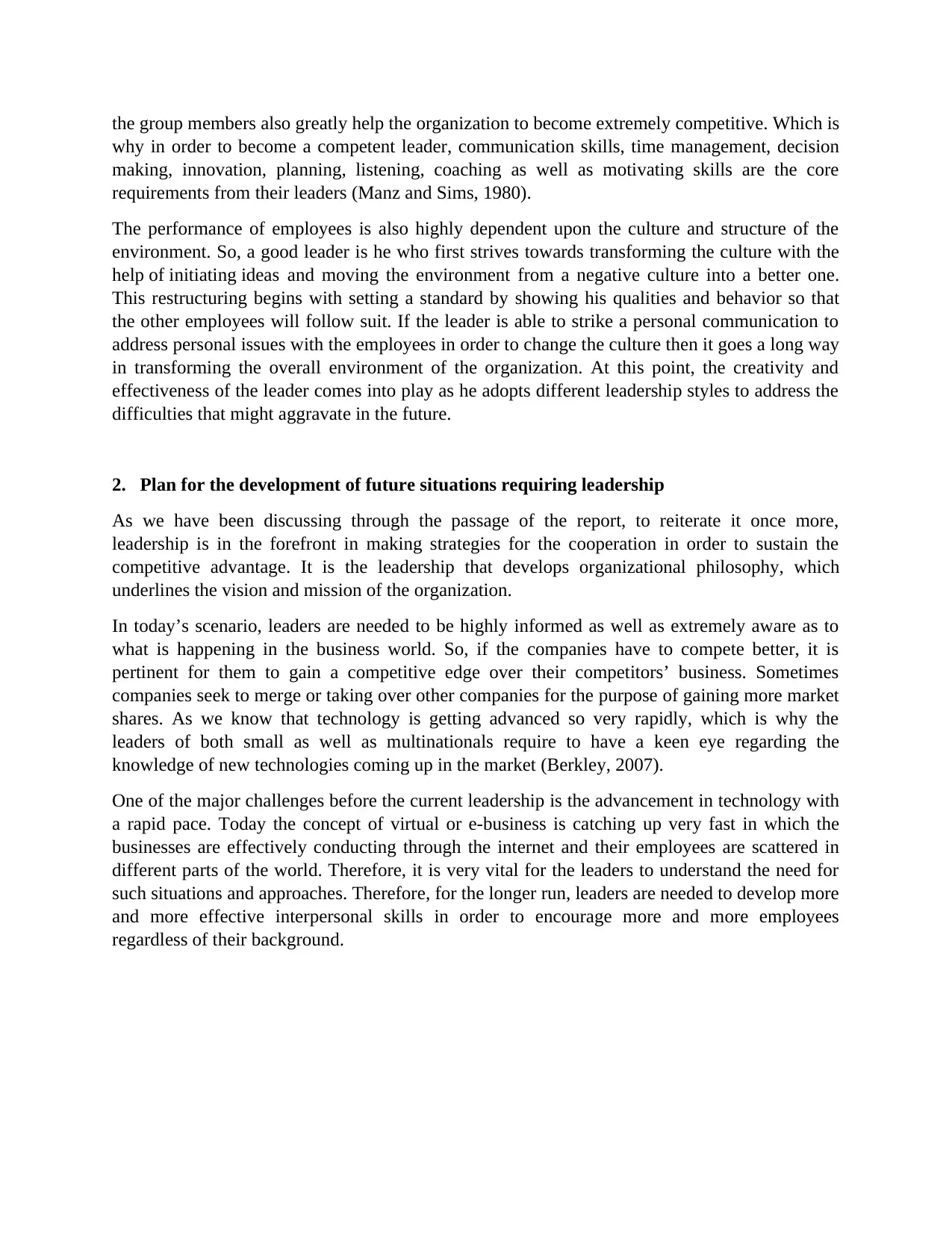
the group members also greatly help the organization to become extremely competitive. Which is
why in order to become a competent leader, communication skills, time management, decision
making, innovation, planning, listening, coaching as well as motivating skills are the core
requirements from their leaders (Manz and Sims, 1980).
The performance of employees is also highly dependent upon the culture and structure of the
environment. So, a good leader is he who first strives towards transforming the culture with the
help of initiating ideas and moving the environment from a negative culture into a better one.
This restructuring begins with setting a standard by showing his qualities and behavior so that
the other employees will follow suit. If the leader is able to strike a personal communication to
address personal issues with the employees in order to change the culture then it goes a long way
in transforming the overall environment of the organization. At this point, the creativity and
effectiveness of the leader comes into play as he adopts different leadership styles to address the
difficulties that might aggravate in the future.
2. Plan for the development of future situations requiring leadership
As we have been discussing through the passage of the report, to reiterate it once more,
leadership is in the forefront in making strategies for the cooperation in order to sustain the
competitive advantage. It is the leadership that develops organizational philosophy, which
underlines the vision and mission of the organization.
In today’s scenario, leaders are needed to be highly informed as well as extremely aware as to
what is happening in the business world. So, if the companies have to compete better, it is
pertinent for them to gain a competitive edge over their competitors’ business. Sometimes
companies seek to merge or taking over other companies for the purpose of gaining more market
shares. As we know that technology is getting advanced so very rapidly, which is why the
leaders of both small as well as multinationals require to have a keen eye regarding the
knowledge of new technologies coming up in the market (Berkley, 2007).
One of the major challenges before the current leadership is the advancement in technology with
a rapid pace. Today the concept of virtual or e-business is catching up very fast in which the
businesses are effectively conducting through the internet and their employees are scattered in
different parts of the world. Therefore, it is very vital for the leaders to understand the need for
such situations and approaches. Therefore, for the longer run, leaders are needed to develop more
and more effective interpersonal skills in order to encourage more and more employees
regardless of their background.
why in order to become a competent leader, communication skills, time management, decision
making, innovation, planning, listening, coaching as well as motivating skills are the core
requirements from their leaders (Manz and Sims, 1980).
The performance of employees is also highly dependent upon the culture and structure of the
environment. So, a good leader is he who first strives towards transforming the culture with the
help of initiating ideas and moving the environment from a negative culture into a better one.
This restructuring begins with setting a standard by showing his qualities and behavior so that
the other employees will follow suit. If the leader is able to strike a personal communication to
address personal issues with the employees in order to change the culture then it goes a long way
in transforming the overall environment of the organization. At this point, the creativity and
effectiveness of the leader comes into play as he adopts different leadership styles to address the
difficulties that might aggravate in the future.
2. Plan for the development of future situations requiring leadership
As we have been discussing through the passage of the report, to reiterate it once more,
leadership is in the forefront in making strategies for the cooperation in order to sustain the
competitive advantage. It is the leadership that develops organizational philosophy, which
underlines the vision and mission of the organization.
In today’s scenario, leaders are needed to be highly informed as well as extremely aware as to
what is happening in the business world. So, if the companies have to compete better, it is
pertinent for them to gain a competitive edge over their competitors’ business. Sometimes
companies seek to merge or taking over other companies for the purpose of gaining more market
shares. As we know that technology is getting advanced so very rapidly, which is why the
leaders of both small as well as multinationals require to have a keen eye regarding the
knowledge of new technologies coming up in the market (Berkley, 2007).
One of the major challenges before the current leadership is the advancement in technology with
a rapid pace. Today the concept of virtual or e-business is catching up very fast in which the
businesses are effectively conducting through the internet and their employees are scattered in
different parts of the world. Therefore, it is very vital for the leaders to understand the need for
such situations and approaches. Therefore, for the longer run, leaders are needed to develop more
and more effective interpersonal skills in order to encourage more and more employees
regardless of their background.
⊘ This is a preview!⊘
Do you want full access?
Subscribe today to unlock all pages.

Trusted by 1+ million students worldwide
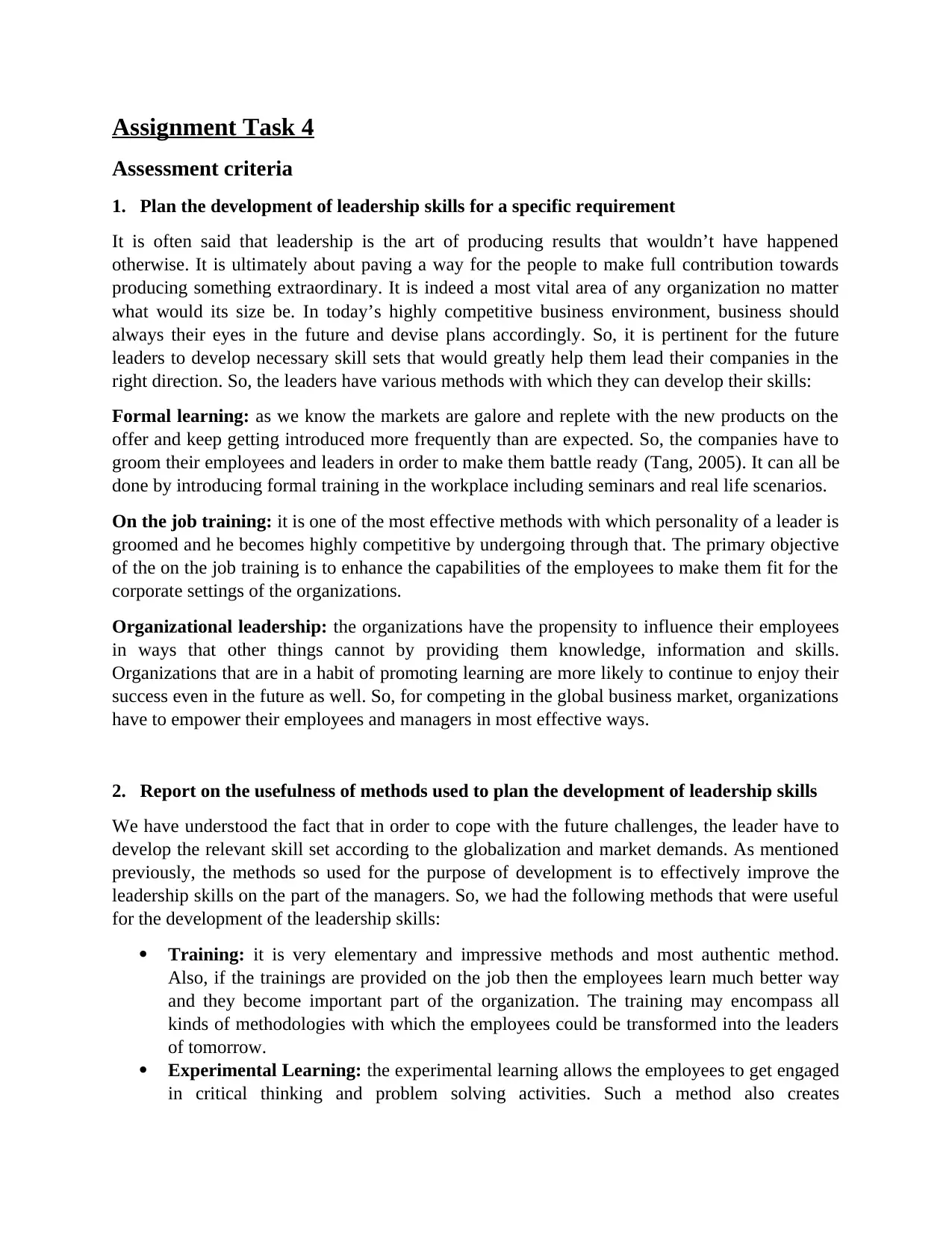
Assignment Task 4
Assessment criteria
1. Plan the development of leadership skills for a specific requirement
It is often said that leadership is the art of producing results that wouldn’t have happened
otherwise. It is ultimately about paving a way for the people to make full contribution towards
producing something extraordinary. It is indeed a most vital area of any organization no matter
what would its size be. In today’s highly competitive business environment, business should
always their eyes in the future and devise plans accordingly. So, it is pertinent for the future
leaders to develop necessary skill sets that would greatly help them lead their companies in the
right direction. So, the leaders have various methods with which they can develop their skills:
Formal learning: as we know the markets are galore and replete with the new products on the
offer and keep getting introduced more frequently than are expected. So, the companies have to
groom their employees and leaders in order to make them battle ready (Tang, 2005). It can all be
done by introducing formal training in the workplace including seminars and real life scenarios.
On the job training: it is one of the most effective methods with which personality of a leader is
groomed and he becomes highly competitive by undergoing through that. The primary objective
of the on the job training is to enhance the capabilities of the employees to make them fit for the
corporate settings of the organizations.
Organizational leadership: the organizations have the propensity to influence their employees
in ways that other things cannot by providing them knowledge, information and skills.
Organizations that are in a habit of promoting learning are more likely to continue to enjoy their
success even in the future as well. So, for competing in the global business market, organizations
have to empower their employees and managers in most effective ways.
2. Report on the usefulness of methods used to plan the development of leadership skills
We have understood the fact that in order to cope with the future challenges, the leader have to
develop the relevant skill set according to the globalization and market demands. As mentioned
previously, the methods so used for the purpose of development is to effectively improve the
leadership skills on the part of the managers. So, we had the following methods that were useful
for the development of the leadership skills:
Training: it is very elementary and impressive methods and most authentic method.
Also, if the trainings are provided on the job then the employees learn much better way
and they become important part of the organization. The training may encompass all
kinds of methodologies with which the employees could be transformed into the leaders
of tomorrow.
Experimental Learning: the experimental learning allows the employees to get engaged
in critical thinking and problem solving activities. Such a method also creates
Assessment criteria
1. Plan the development of leadership skills for a specific requirement
It is often said that leadership is the art of producing results that wouldn’t have happened
otherwise. It is ultimately about paving a way for the people to make full contribution towards
producing something extraordinary. It is indeed a most vital area of any organization no matter
what would its size be. In today’s highly competitive business environment, business should
always their eyes in the future and devise plans accordingly. So, it is pertinent for the future
leaders to develop necessary skill sets that would greatly help them lead their companies in the
right direction. So, the leaders have various methods with which they can develop their skills:
Formal learning: as we know the markets are galore and replete with the new products on the
offer and keep getting introduced more frequently than are expected. So, the companies have to
groom their employees and leaders in order to make them battle ready (Tang, 2005). It can all be
done by introducing formal training in the workplace including seminars and real life scenarios.
On the job training: it is one of the most effective methods with which personality of a leader is
groomed and he becomes highly competitive by undergoing through that. The primary objective
of the on the job training is to enhance the capabilities of the employees to make them fit for the
corporate settings of the organizations.
Organizational leadership: the organizations have the propensity to influence their employees
in ways that other things cannot by providing them knowledge, information and skills.
Organizations that are in a habit of promoting learning are more likely to continue to enjoy their
success even in the future as well. So, for competing in the global business market, organizations
have to empower their employees and managers in most effective ways.
2. Report on the usefulness of methods used to plan the development of leadership skills
We have understood the fact that in order to cope with the future challenges, the leader have to
develop the relevant skill set according to the globalization and market demands. As mentioned
previously, the methods so used for the purpose of development is to effectively improve the
leadership skills on the part of the managers. So, we had the following methods that were useful
for the development of the leadership skills:
Training: it is very elementary and impressive methods and most authentic method.
Also, if the trainings are provided on the job then the employees learn much better way
and they become important part of the organization. The training may encompass all
kinds of methodologies with which the employees could be transformed into the leaders
of tomorrow.
Experimental Learning: the experimental learning allows the employees to get engaged
in critical thinking and problem solving activities. Such a method also creates
Paraphrase This Document
Need a fresh take? Get an instant paraphrase of this document with our AI Paraphraser
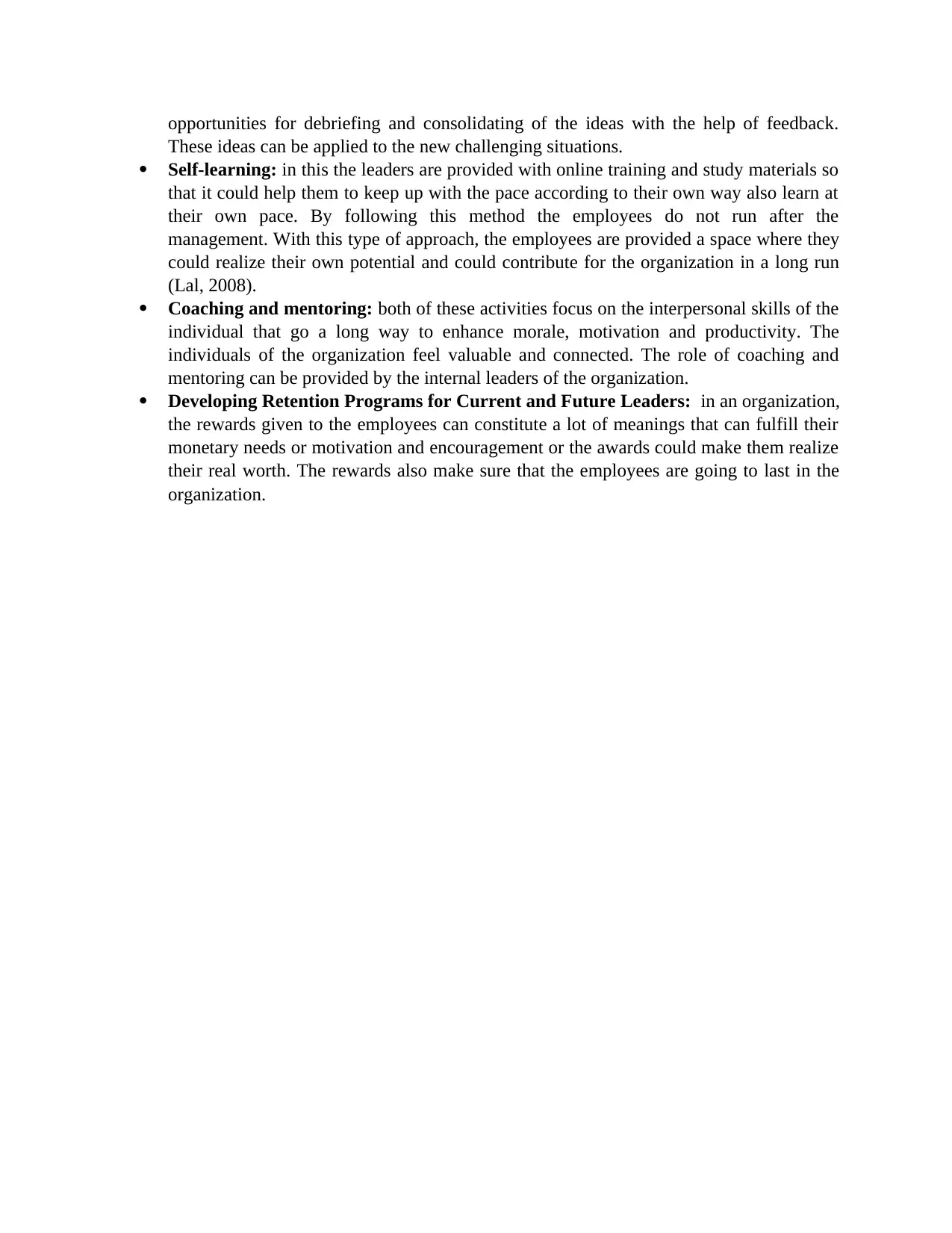
opportunities for debriefing and consolidating of the ideas with the help of feedback.
These ideas can be applied to the new challenging situations.
Self-learning: in this the leaders are provided with online training and study materials so
that it could help them to keep up with the pace according to their own way also learn at
their own pace. By following this method the employees do not run after the
management. With this type of approach, the employees are provided a space where they
could realize their own potential and could contribute for the organization in a long run
(Lal, 2008).
Coaching and mentoring: both of these activities focus on the interpersonal skills of the
individual that go a long way to enhance morale, motivation and productivity. The
individuals of the organization feel valuable and connected. The role of coaching and
mentoring can be provided by the internal leaders of the organization.
Developing Retention Programs for Current and Future Leaders: in an organization,
the rewards given to the employees can constitute a lot of meanings that can fulfill their
monetary needs or motivation and encouragement or the awards could make them realize
their real worth. The rewards also make sure that the employees are going to last in the
organization.
These ideas can be applied to the new challenging situations.
Self-learning: in this the leaders are provided with online training and study materials so
that it could help them to keep up with the pace according to their own way also learn at
their own pace. By following this method the employees do not run after the
management. With this type of approach, the employees are provided a space where they
could realize their own potential and could contribute for the organization in a long run
(Lal, 2008).
Coaching and mentoring: both of these activities focus on the interpersonal skills of the
individual that go a long way to enhance morale, motivation and productivity. The
individuals of the organization feel valuable and connected. The role of coaching and
mentoring can be provided by the internal leaders of the organization.
Developing Retention Programs for Current and Future Leaders: in an organization,
the rewards given to the employees can constitute a lot of meanings that can fulfill their
monetary needs or motivation and encouragement or the awards could make them realize
their real worth. The rewards also make sure that the employees are going to last in the
organization.
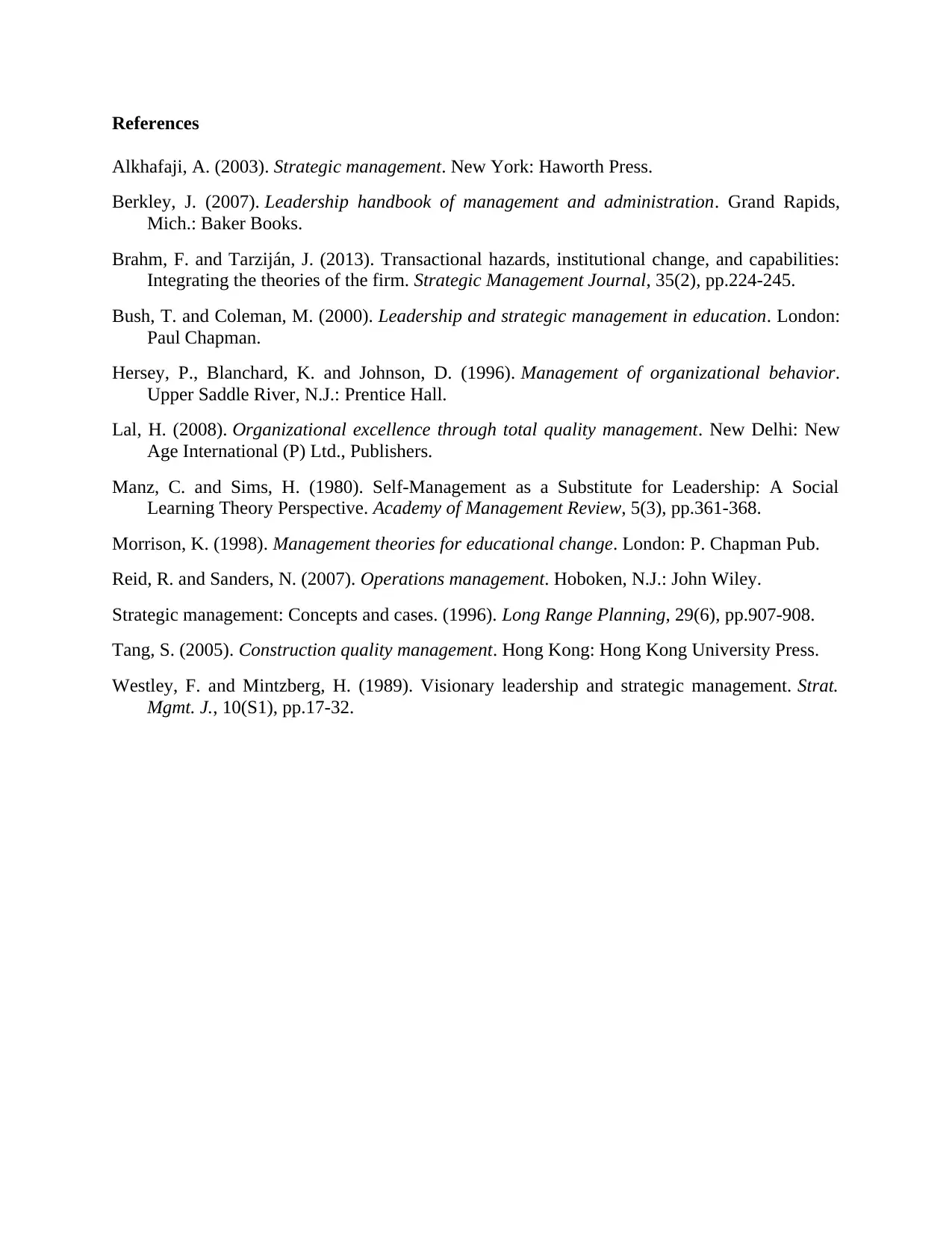
References
Alkhafaji, A. (2003). Strategic management. New York: Haworth Press.
Berkley, J. (2007). Leadership handbook of management and administration. Grand Rapids,
Mich.: Baker Books.
Brahm, F. and Tarziján, J. (2013). Transactional hazards, institutional change, and capabilities:
Integrating the theories of the firm. Strategic Management Journal, 35(2), pp.224-245.
Bush, T. and Coleman, M. (2000). Leadership and strategic management in education. London:
Paul Chapman.
Hersey, P., Blanchard, K. and Johnson, D. (1996). Management of organizational behavior.
Upper Saddle River, N.J.: Prentice Hall.
Lal, H. (2008). Organizational excellence through total quality management. New Delhi: New
Age International (P) Ltd., Publishers.
Manz, C. and Sims, H. (1980). Self-Management as a Substitute for Leadership: A Social
Learning Theory Perspective. Academy of Management Review, 5(3), pp.361-368.
Morrison, K. (1998). Management theories for educational change. London: P. Chapman Pub.
Reid, R. and Sanders, N. (2007). Operations management. Hoboken, N.J.: John Wiley.
Strategic management: Concepts and cases. (1996). Long Range Planning, 29(6), pp.907-908.
Tang, S. (2005). Construction quality management. Hong Kong: Hong Kong University Press.
Westley, F. and Mintzberg, H. (1989). Visionary leadership and strategic management. Strat.
Mgmt. J., 10(S1), pp.17-32.
Alkhafaji, A. (2003). Strategic management. New York: Haworth Press.
Berkley, J. (2007). Leadership handbook of management and administration. Grand Rapids,
Mich.: Baker Books.
Brahm, F. and Tarziján, J. (2013). Transactional hazards, institutional change, and capabilities:
Integrating the theories of the firm. Strategic Management Journal, 35(2), pp.224-245.
Bush, T. and Coleman, M. (2000). Leadership and strategic management in education. London:
Paul Chapman.
Hersey, P., Blanchard, K. and Johnson, D. (1996). Management of organizational behavior.
Upper Saddle River, N.J.: Prentice Hall.
Lal, H. (2008). Organizational excellence through total quality management. New Delhi: New
Age International (P) Ltd., Publishers.
Manz, C. and Sims, H. (1980). Self-Management as a Substitute for Leadership: A Social
Learning Theory Perspective. Academy of Management Review, 5(3), pp.361-368.
Morrison, K. (1998). Management theories for educational change. London: P. Chapman Pub.
Reid, R. and Sanders, N. (2007). Operations management. Hoboken, N.J.: John Wiley.
Strategic management: Concepts and cases. (1996). Long Range Planning, 29(6), pp.907-908.
Tang, S. (2005). Construction quality management. Hong Kong: Hong Kong University Press.
Westley, F. and Mintzberg, H. (1989). Visionary leadership and strategic management. Strat.
Mgmt. J., 10(S1), pp.17-32.
⊘ This is a preview!⊘
Do you want full access?
Subscribe today to unlock all pages.

Trusted by 1+ million students worldwide
1 out of 9
Related Documents
Your All-in-One AI-Powered Toolkit for Academic Success.
+13062052269
info@desklib.com
Available 24*7 on WhatsApp / Email
![[object Object]](/_next/static/media/star-bottom.7253800d.svg)
Unlock your academic potential
Copyright © 2020–2025 A2Z Services. All Rights Reserved. Developed and managed by ZUCOL.





